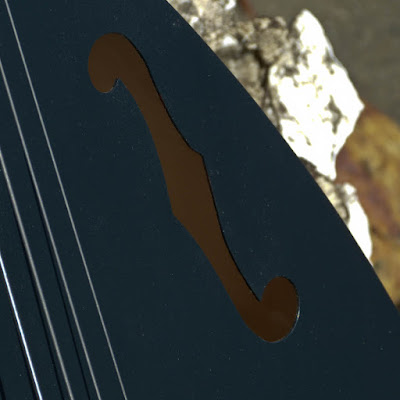2016 Jake Wildwood Mandobass
I've wanted to build a mandobass for some years, now, but just hadn't put aside the time to build one. Early this month I drew up some plans, thought up some ideas, and ordered all the kit I'd need to "make it so." I sold-off some instruments to afford supplies and fund my "lost time" building it, and then proceeded to let the stuff sit until Wednesday of last week. Our bass player, Ron, had a different gig to go to on Friday so I decided to push myself and get this done in two days. It happened!
I played this for two hours "in the white" and fresh off the bench on Friday night down at The Wild Fern. It also "learned" how to play it, too, and after half an hour I was getting a good sound out of it that fairly-easily supported a couple of guitars and two mando players. When I first strung it up I was nonplussed as I'd just plucked it "upright" style. After whacking it with a couple of heavy-duty picks closer to the bridge (mandobass-style) it did exactly what I wanted it to do in the first place -- it gave that percussive, almost P-bass "grump" sound and pushed out enough volume to be useful.
It's certainly not a bass for everyone, but if you're used to using a pick on an electric bass and don't mind strong-arming your instrument with the right hand, it's actually a very good choice and has a punchy, growly tone that supports folksy music quite well. It has a distinctively different tone from an upright bass but isn't as confined tonally (oom-pah-pah, growl-growl) as my last practical banjo bass design.
The idea behind this instrument was that it should be no-frills and sturdy as heck. From playing uprights "out" I got sick of them bouncing against walls and headstock scrolls and whatnot and cringing every time I did so.
There's no binding and the top and headstock are painted a dark, dark, forest green. The body is entirely made from 1/16" birch plywood ("aircraft grade") that's quite flexible and the top is tonebar-braced using 100-year-old tight spruce stock that I cut from the posts of a broken old player piano.
The build is "through neck" in that the center portion of the neck (all maple) runs right from the endblock through to the top of the headstock. This gives it a ton of structural integrity and allowed me to forego a lot of "molds" by building the body directly off of the "center beam." The ply is so thin that it simply bent without heat/moisture.
I borrowed my scale length/sizing from a few "first generation" Gibson mandobasses that obviously featured a shorter scale (note bridge placement in this above pic) with a more central bridge location. My scale length is standard "electric bass" at 34" and it's strung with 1/4 size upright bass strings (Corelli 350s).
My other design reference was (above) the later, 1930s, "Kalamazoo" Gibson-made mandobasses and from them I borrowed my f-hole ideas, rooftop headstock look, dark-painted top, and spare looks.
Don't look too closely -- I painted and finished this on Saturday/Sunday and it's already gotten a ton of nicks, light scratching, and dings -- a symptom of being a large instrument. The 1 5/8" nut is bone, the tuners are standard "elephant ear" bass units, and the board is 14" radius rosewood with jumbo frets.
My neck is made of three 3/4" pieces of maple with headstock "wings" added. I cut it a deep U-shape like on an average older-style upright bass. I didn't want a truss rod and don't like the feel of "thin" bass necks, anyhow, so this "big boy" size was the right answer for me.
Instead of black, I painted the top and "details" a dark green. The sides and neck are stained a red-brown and finished in semi-satin. I kept it simple since I know it's going to get abused by all sorts of handling wear.
The interesting thing about my top design is that the ply is so wobbly that it easily flexes anywhere but right over the braces. I kept my braces stiff and large because of this. In many ways, this means it responds a bit like a banjo and...
...so the bridge became an integral point of design in reaching a good tone. The one in the pics is close to what I have on it now (it's a hunk of cherry), though the current bridge (as of today, Monday) has a third foot in the center, a 1" wider stance, and smaller "feet" on the edges. Power and depth of tone has increased on each bridge redesign.
Above is an update with a shot of the current bridge and various testers. I tried a bunch of different materials including soundboard-quality spruce, cherry, maple, and rosewood, but finally ended-up with a base made of dense, tight-grain old mahogany and an adjustable "topper" of old rosewood.
I've also played with soundposts to adjust tone and ended-up adding a small one that runs from below the treble f-hole (half-way to the bridge) and engages the back. It's absolutely not needed structurally but does give a slightly "rounder" tone in the mids and a less boomy bass.
The tailpiece is a repurposed 12-string unit. I drilled it out for the four thicker strings.
The red-brown stain on the somewhat-figured birch back/sides gives an old-fashioned Gibsonesque look.
The back is unbraced (per my plans) and sort-of works in the same fashion as a bass drum's second head -- giving a nice sympathetic "wumf" to the tone.
Note how I've already managed to mangle my paint job a bit with leaning this on various furniture...
I've seen detailing like this on old Regal instruments from the 30s/40s and I always wanted an excuse to use it.




















Comments
Looks great!
Thanks to both of yas.